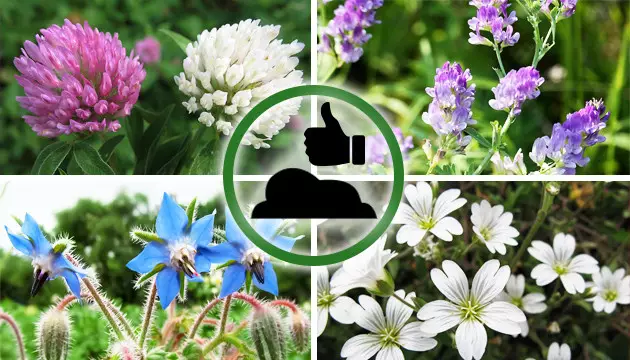Companion Plants For Cannabis: Choosing A Friend For Your Plant

If you’re looking to expand your cannabis garden or move away from store-bought supplies, you may have come across references to “companion planting”. Adding companion plants to your cannabis garden is guaranteed to benefit your garden in countless ways. Follow through this article to learn exactly how this happens.
The Basics Of Companion Planting
Companion planting is the idea of growing multiple types of plants alongside each other in a mutually beneficial relationship. In relation to growing cannabis, growing companion plants in your cannabis garden is a way to protect your plants against pesticides and synthesized fertilizers by using other plants to do the work in their place.
Why You Should Keep Companion Plants

Companion planting is the best way to get away from using manufactured, synthetic nutrients and get back to natural, sustainable gardening. Using companion plants brings naturally-occurring nutrients into the soil and nourishes all the plants in your garden; it also protects the integrity of your soil. Companion plants for cannabis also act as a natural form of pest control, discouraging pests from invading your garden using the natural repelling factors of your companions and encouraging healthy critters to visit your garden instead.
Use Companions As Pest Control

Some of the best plants to grow with cannabis are those that will keep invasive pests out of your garden. These plants are great at repelling cannabis pests and will help you steer clear of using insecticides and pesticides.
- Chamomile: Chamomile is essentially a plant with a huge “do not enter” sign on its flowers. Chamomile as a cannabis companion plant will help repel mosquitoes and flies, but attract honeybees to fertilize your garden.
- Lavender: Lavender is effective at repelling ticks, fleas, moths and mice. Plant lavender on the edges of your garden to repel these pests and attract honeybees and other larvae-eating insects.
- Dill: Dill is the best herb against pests that love to invade cannabis, such as aphids, swallowtail caterpillars and spider mites. These critters love dill, and will happily forgo your cannabis for dill instead.
- Coriander: Coriander is also excellent at repelling aphids, spider mites and potato beetles. You can also use ground coriander seeds as a natural insecticide by spraying it over your garden.
- Basil: Known as the “king of herbs”, basil will repel almost any pest from invading your garden, particularly aphids, asparagus beetles, mosquitoes, whiteflies and hornworms.
- Yarrow: Although yarrow repels a wide range of pests, it works best to attract predatory insects that feed on common garden pests, including ladybugs, aphid lions and hoverflies.
- Sunflowers: One of the best things about sunflowers in your garden is their appearance. They are large, big, bright and distracting: sunflowers will surely draw the attention of sap-hungry pests away from your plants on the ground and up toward the yellow suns of sunflowers.
Choosing Companions For Healthy Soil

Healthy soil is the cornerstone for healthy cannabis plants. The following are some of the best plants to grow with cannabis to ensure a healthy, rich soil without having to use synthetic fertilizers or nutrient supplements.
- White Clover: As plants decay, they release nitrogen into the soil. Plants crave nitrogen, and the unique root structure of white clover fixes nitrogen levels in the soil so that your neighboring plants can access it more easily.
- Red Clover: Red clover is excellent to use as a cannabis companion plant for its ability to create a natural drainage system in the soil. Red clover is also a nitrogen fixer and will regulate the levels of this nutrient.
- Alfalfa: Alfalfa is one of the best plants at providing nutrients. Alfalfa accumulates magnesium, potassium, iron and phosphorus while increasing water retention of your soil. Alfalfa also fixes nitrogen levels in the soil.
- Borage: Borage is excellent not only because it releases a plethora of different vitamins and nutrients into the soil, but also because even in death, it’s an excellent source of fertilizer. When composted, borage will cause a slow-release of potassium and calcium.
- Cerastium: Cerastium is, basically, living mulch. It creates a canopy over the soil which increases water penetration and retention, keeping soil moist. Cerastium is also a great source for compost material for its high level of nutrients.
Keep It Hidden: Camouflage Companions

When growing cannabis, particularly outdoors, it’s often important to be discreet. These plants especially can help keep your weed hidden.
- Lavender: Thanks to its strong and distinctive odor, your cannabis plants will go virtually unnoticed alongside lavender bushes. Lavender is also sure to draw the eyes of passersby away from your cannabis.
- Sunflowers: As if sunflowers weren’t helpful enough already, they’re also excellent for camouflaging your cannabis. They are so tall and so bright that they’re sure to create the perfect cannabis cover crop.
- Bamboo: Bamboo is also an excellent choice for hiding your plants. Bamboo grows tall and thick, and is excellent at hiding anything in your garden when planted in the right places.
- Lemon Balm: Lemon balm is an excellent companion plant for your cannabis thanks to its bright smell. Lemon balm can infuse surrounding plants with its distinct citrusy scent, helping to further camouflage the odor of your cannabis.
Companion Plants: Organic And Purely Beneficial
Companion planting is an excellent method of returning to natural gardening, foregoing the need for store-bought or synthetic products. In fact, growing other plants alongside your cannabis is sure to provide your garden – and your kitchen – with so many benefits that you’ll never want to go back to your old gardening habits!
Herbies Head Shop expressly refuses to support the use, production, or supply of illegal substances. For more details read our Legal Disclaimer.












Thank you for leaving a comment for us!
Your feedback will be posted shortly after our moderator checks it.
Please note that we don’t publish reviews that: